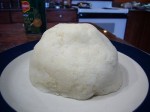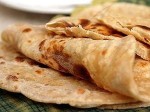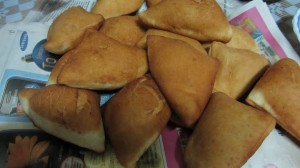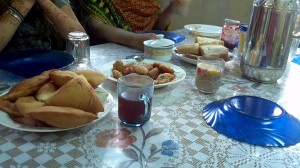During our three weeks on Lamu we rented two rooms from Majid and his family. We got full board, eating three meals a day with them. Zainab, Majid’s mother, normally lives in Dubai, but luckily she was visiting at the same time we were. She did most of the cooking, and her food was amazing.
Swahili cuisine has been influenced by the Arabs, the Indians, the Europeans (particularly the Portuguese) and, of course, the Africans. A starchy food is always the mainstay of lunch and dinner.  There is the African specialty, ugali, a cornmeal cooked into a thick porridge. It tastes like a very bland masa harina unless it’s been cooked with coconut milk and then is slightly sweet. Rice is served often, either steamed or made into a pilau.
There is the African specialty, ugali, a cornmeal cooked into a thick porridge. It tastes like a very bland masa harina unless it’s been cooked with coconut milk and then is slightly sweet. Rice is served often, either steamed or made into a pilau.  Wheat flour is made into tortilla-like chapatis. These are often sold by the side of the road for 10 shillings (1 cent). We would use them as a utensil, picking up our stews or vegetables with them. And we ate potatoes, often in broth, as well.
Wheat flour is made into tortilla-like chapatis. These are often sold by the side of the road for 10 shillings (1 cent). We would use them as a utensil, picking up our stews or vegetables with them. And we ate potatoes, often in broth, as well.
Dishes served with the starch included goat stews, fried fish, vegetable stews, and beans. There was one dish of beans I could not get enough of. The beans were ever so soft and flavored gently with chilies. Everything was well seasoned but not as heavily as Indian food. Nothing was hot-burning spicy. The stews were accompanied by chutneys: date, dried mango, chili, coconut, or seaweed.
Goat stew one lunch was made from the goat slaughtered in the back yard that morning. Hank had watched the slaughter and couldn’t stomach the stew to follow. Admittedly, there were body parts in it we don’t typically eat in the States. Still by dinner, Hank was once again down with eating goat. My favorite was a dish of chapatis filled with spiced, chopped goat meat. It reminded me of the gözleme of Turkey, but with a thicker pancake and different spices in the meat.
 For breakfast there were always mandazi, triangles of slightly sweet wheat dough deep fried. As well, John, one of their hired help, went out every morning for fresh fritters of ground beans with spices and herb, much like pakoras. Occasionally, we had bhajia, lightly battered and fried potatoes. I have to admit with all the fried food for breakfast, I loved when we added a banana to the meal.
For breakfast there were always mandazi, triangles of slightly sweet wheat dough deep fried. As well, John, one of their hired help, went out every morning for fresh fritters of ground beans with spices and herb, much like pakoras. Occasionally, we had bhajia, lightly battered and fried potatoes. I have to admit with all the fried food for breakfast, I loved when we added a banana to the meal.  To wash everything down we drank milk tea, spiced with cardamom but unsweetened, or black tea with ginger and sweetened with sugar. I always combined the two to have a slightly spicy, slightly sweet, milky cup of tea. It was amazing how much that hot drink would make me sweat in the warmth of the island.
To wash everything down we drank milk tea, spiced with cardamom but unsweetened, or black tea with ginger and sweetened with sugar. I always combined the two to have a slightly spicy, slightly sweet, milky cup of tea. It was amazing how much that hot drink would make me sweat in the warmth of the island.
The people of Lamu use their hands to eat. Or more specifically their right hands. The food on the plate is mixed by the right hand and then a small bite is held, pinched between the fingers and the thumb. The thumb is then used as a squeegee pushing the food into the mouth from off the fingers. It is considered impolite to have the food reach beyond the fingers to the palm. Turns out there’s even an etiquette to eating with your hands. My family tried for about a week to eat with our hands. Turns out, we couldn’t do it. There were always utensils for us on the table. Eventually we all broke down and started using forks and spoons. Our hosts asked us if we ever ate with sticks. Why, of course, we exclaimed. They found it amusing we were more willing to make eating more complicated rather than less. (One of the consequences of eating with their hands is they often have a sink in their dining room. Makes for an odd decoration in the eyes of us Westerners who use forks and spoons.)
Zainab was incredibly thoughtful of my vegetarian daughter, always making a separate vegetarian dish and often a vegetarian variation of the main dish for Cat. She would even cook the vegetarian dish before the meat dish so that no meat would contaminate my daughter’s food. Few cooks are so thoughtful. When Cat got sick and unable to eat, we could see that Zainab was a bit hurt by Cat’s refusal to eat. When Cat likes her food, she’s so much fun to feed. She relishes her food. Zainab smiled from ear to ear when Cat was better and once again starting eating and complimenting the food.
One of our last meals in Lamu was one of Zainab’s finests. We had guests, eight in all, plus Zainab, Majid, and Thuweba, Sundus and Said, their kids, and the four of us.  There wasn’t room at the table for all of us, so we sat on the floor with a long table cloth to define the table. There was goat stew with potatoes and chilies, rice pilau, bhajia, mandazi, greens, and my favorite pot of beans. Of course, there was milk and black teas to drink. And so much talk, in English, Swahili, and, yes, once again some German. After the meal we all sang old rock and roll songs to a guitar. The delicious foods of the Swahili cuisine had warmed our bellies, our voices, and our hearts. We were very fortunate to have Zainab introduce us to the Swahili cuisine. We were very fortunate to have her family to introduce us to Swahili culture. Thank you, Zainab, Majid, and Thuweba for all your hospitality.
There wasn’t room at the table for all of us, so we sat on the floor with a long table cloth to define the table. There was goat stew with potatoes and chilies, rice pilau, bhajia, mandazi, greens, and my favorite pot of beans. Of course, there was milk and black teas to drink. And so much talk, in English, Swahili, and, yes, once again some German. After the meal we all sang old rock and roll songs to a guitar. The delicious foods of the Swahili cuisine had warmed our bellies, our voices, and our hearts. We were very fortunate to have Zainab introduce us to the Swahili cuisine. We were very fortunate to have her family to introduce us to Swahili culture. Thank you, Zainab, Majid, and Thuweba for all your hospitality.

2 Responses to Swahili Food